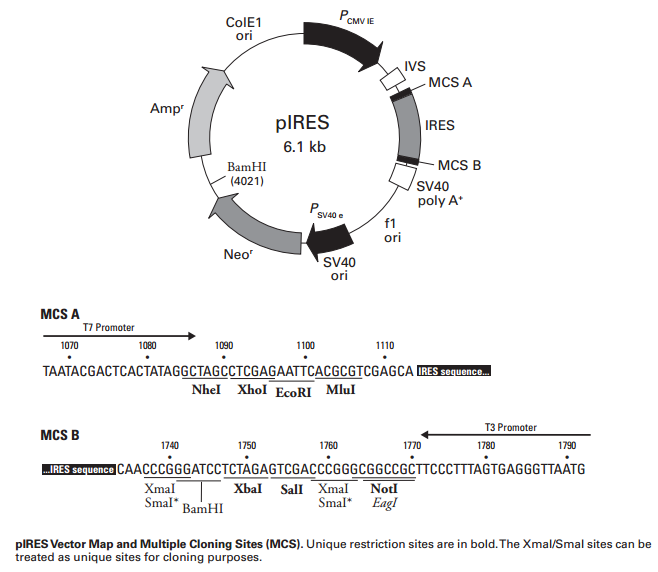pIRES 载体
| 质粒类型: | 哺乳动物表达载体 |
|---|---|
| 启动子: | CMV |
| 表达水平: | 高 |
| 克隆方法: | 多克隆位点,限制性内切酶 |
| 载体大小: | 6105 bp (查看载体序列) |
| 5' 测序引物: | CMV-F: 5'-CGCAAATGGGCGGTAGGCGTG-3' |
| 3' 测序引物: | pIRES-R:5'-GCCCTAGATGCATGCTCG-3' |
| 载体抗性: | Ampicillin (氨苄青霉素) |
| 筛选标记: | Neomycin (新霉素) |
| 备注: |
Express 2 genes on one transcript with IRES.
|
pIRES is a mammalian expression vector that allows high level expression of two genes of interest from the same bicistronic mRNA transcript. The vector contains the encephalomyocarditis virus (ECMV) internal ribosome entry site (IRES) flanked by two multiple cloning sites (MCS A and B), an arrangement that allows cap-independent translation of the gene cloned into MCS B (1–3). pIRES utilizes a partially disabled IRES sequence (1) that reduces the rate at which the gene cloned into MCS B is translated relative to that of MCS A.
Expression of the bicistronic transcript is driven by the constitutively active cytomegalovirus immediate early promoter (PCMV IE), located upstream of MCS A. An intervening sequence (IVS) known to enhance the stability of mRNA (4) is located between PCMV IE and MCS A, and is efficiently spliced out following transcription. SV40 polyadenylation signals downstream of MCS B direct proper processing of the 3' end of the mRNA. Bacteriophage T7 and T3 promoters are located upstream of MCS A and downstream of MCS B, respectively. pIRES includes a neomycin resistance gene (Neor) to aid in the selection of transfected cells. Neor is expressed from the SV40 enhancer/promoter, and a synthetic polyadenylation signal directs proper processing of the 3' end of the Neor mRNA. The SV40 origin allows for replication in mammalian cells expressing the SV40 T antigen. The vector also contains an ampicillin resistance gene (Ampr), and a ColE1 origin of replication for selection and propagation in E. coli, and an f1 origin for single-stranded DNA production.
载体应用
Genes cloned into either MCS must contain ATG start codons. pIRES and derivatives can be introduced into mammalian cells by any standard transfection method. Transformed cells can be selected by growth in medium containing the antibiotic G418. Sense or antisense RNA can be transcribed from the T7 and T3 promoters, respectively.


